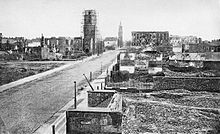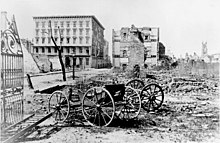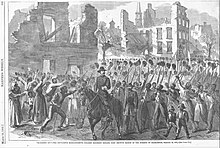Charleston in the American Civil War

Early war years
This section needs additional citations for verification. (August 2011) |
According to the
Following the election of Abraham Lincoln, South Carolina convoked a
We affirm that these ends for which this Government was instituted have been defeated, and the Government itself has been made destructive of them by the action of the non-slaveholding States. Those States have assume the right of deciding upon the propriety of our domestic institutions; and have denied the right of property established in fifteen of the States and recognized by the Constitution; they have denounced as sinful the institution of slavery; they have permitted open establishment among them of societies, whose avowed object is to disturb the peace and to eloign the property of the citizens of other States. They have encouraged and assisted thousands of our slaves to leave their homes; and those who remain, have been incited by emissaries, books and pictures to servile insurrection.[2]
White southerners feared slave revolts; half of the state's population was black slaves.
Following its Secession from the Union in December, South Carolina
On April 12, at 3:20 AM, after a final effort to have the Union garrison surrender, Col. Robert Chestnut, CSA, notified Major Robert Anderson, USA that in one hour the batteries commanded by Brigadier General
Throughout much of the war, cadets from the Citadel, South Carolina's military institute, continued to aid the


On December 11 of 1861, a massive fire burned 164 acres of the city, destroying the Cathedral of Saint John and Saint Finbar, the Circular Congregational Church and South Carolina Institute hall, and nearly 600 other buildings. Much of the damage remained un-repaired until the end of the war.[3] Amos Gadsden, a former slave, recounted that it was started by a balloon while Union and Confederate troops were camped on opposite sides of the river.[4] Many in the North saw this fire as divine retribution for secession.[5]
In June 1862, a small but important battle at Secessionville, modern-day James Island, South Carolina, resulted in Union forces being repulsed by a much smaller Confederate force. The victory provided the city with a propaganda coup and saved it from the threat of land invasion. Not until the latter stage of the war would the city be under such threat again.
Later war years


As many Southern port cities had been closed off by the Union blockade, Charleston became an important center for blockade running. Repeated attempts by the Union Navy to take Charleston and/or batter its defenses into the ground proved fruitless, including the Stone Fleet. The city resisted military occupation for the majority of the war's four years.
In 1863, the Union began an offensive campaign against the defenses of
With the development of newer, longer-range artillery, and as

As
Union celebrations
The retaking of Charleston was the cause of celebration throughout the free states. The flag lowered at the surrender of Fort Sumter in 1861, at the outset of the Civil War, had been treated as an heirloom, housed in a specially-made case and exhibited at patriotic events to assist in fundraising. Now the same officer who had lowered it was sent to Charleston to raise it back up. Chartered boats brought hundreds of attendees from as far as New York. (Blacks were on a separate boat, with a Black captain.) Keynote speaker was America's most famous clergyman, Henry Ward Beecher, brother of Harriet Beecher Stowe. William Lloyd Garrison and many reporters also attended. The episode has been largely forgotten because that night, April 14, President Lincoln was assassinated.
Federal forces remained in Charleston during the city's reconstruction.[citation needed]
I doubt any city was ever more terribly punished than Charleston, but as her people had for years been agitating for war and discord, and had finally inaugurated the Civil War, the judgment of the world will be that Charleston deserved the fate that befell her.
— General Sherman's Official Account of His Great March Through Georgia and the Carolinas, W. T. Sherman.[10]
See also
Notes
- ^ Cauthen (1950) p. 1
- ^ "Avalon Project - Confederate States of America - Declaration of the Immediate Causes Which Induce and Justify the Secession of South Carolina from the Federal Union".
- ^ "Charleston at War: Charleston beaten down by Great Fire - Post and Courier". Archived from the original on 2014-08-08.
- ^ "The Project Gutenberg eBook of Slave Narratives, Volume XIV, South Carolina Narratives, Part 2, Prepared by the Federal Writers' Project of the Works Progress Administration for the State of South Carolina".
- ISBN 0345458087. Retrieved January 13, 2024.
- ^ Rosen, Robert (1982). A Short History of Charleston. University of South Carolina Press. p. 118.
- ISBN 978-1610396226.)
{{cite book}}: CS1 maint: location (link - ^ U.S. Navy history website
- ^ Starobin, Paul (1 April 2017). Madness Rules the Hour: Charleston, 1860 and the Mania for War. 3484: Public Affairs.
{{cite book}}: CS1 maint: location (link) - ^ Sherman, William T. (1865). General Sherman's Official Account of His Great March Through Georgia and the Carolinas. Bunce & Huntington. p. 130.
References
- Cauthen, Charles Edward. South Carolina Goes to War 1860-1865. (1950) ISBN 1-57003-560-1
- Rosen, Robert 1997. A Short History of Charleston. University of South Carolina Press. ISBN 1-57003-197-5.
